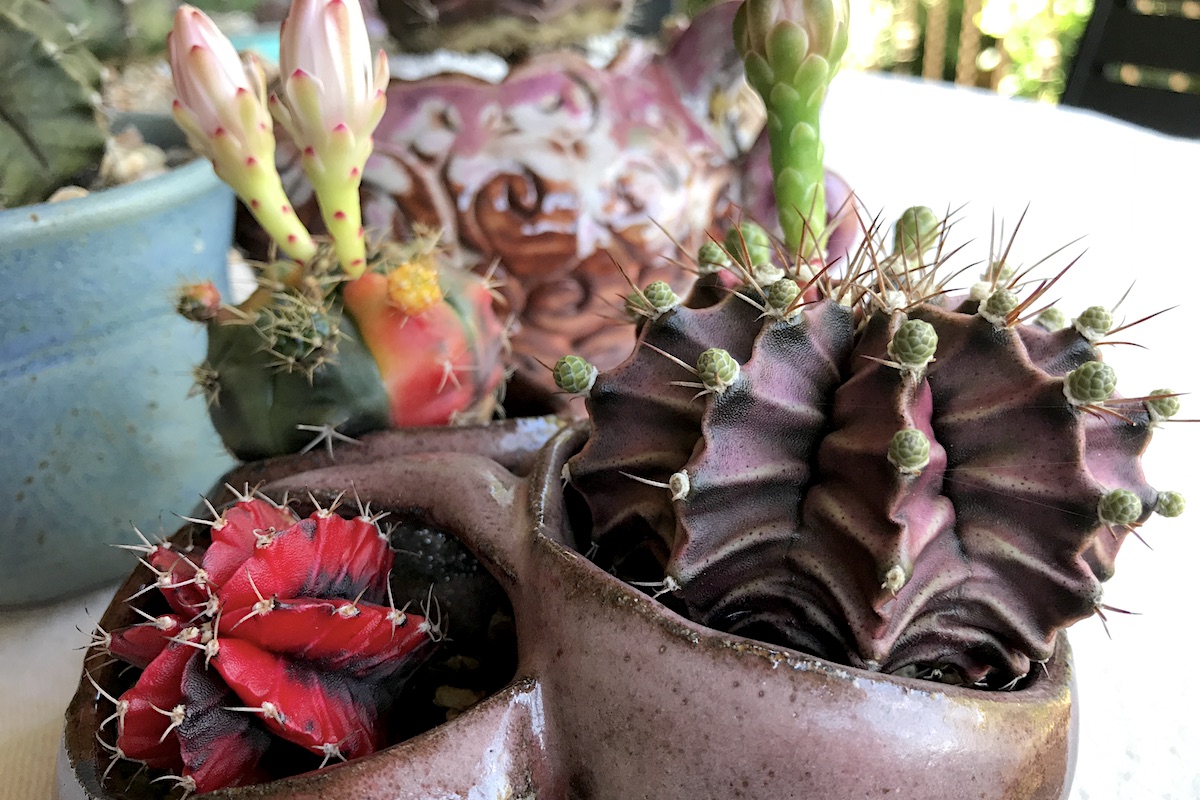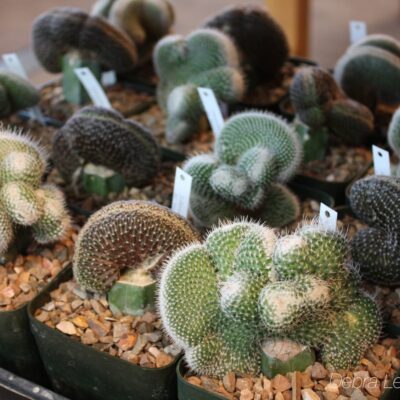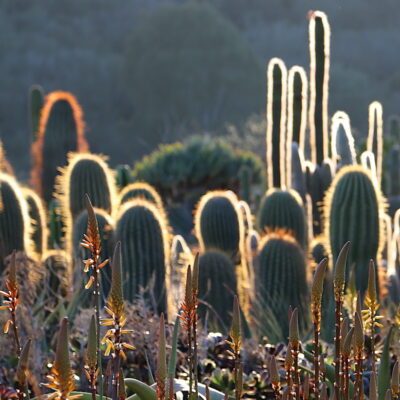
Hidden Gymnos: My Thai Succulent Mystery
Will you help me solve a mystery? I'm wondering why someone would hide valuable, collectible cacti (Gymnocalycium mihanovichii variegata) in a pastry box and ship them to me from overseas.
Eight months ago
In mid-December a package from Thailand arrived with no explanation. Inside was a box of commercial pastries similar to Hostess cupcakes. I assumed it resulted from a translation error on an overseas order. Cleaning up after the holidays, I was about to throw it away when I noticed it had been resealed.

Thai pastry box with gymnocalyciums (after I unwrapped and potted them).
I opened the box and pulled out something round, firm and wrapped in paper towels. (I figured Thai food packaging standards must be pretty lenient.) OMG. There were three spherical cacti with desiccated roots...along with several prepackaged pastries. The largest cactus was the size of a tennis ball.
I recalled that on Instagram Thai nurseries post photos of gorgeous gymnocalyciums with rainbow-sherbet hues. These were probably similar, but weeks of darkness had muted their colors. At least they were alive (they felt firm) and hopefully would grow new roots. I potted them---basically, set them atop moist cactus mix---placed them in bright shade, and gradually introduced them to greater sun to bring out any colors.
I searched online for gymno growers in the city they came from. I found several but no leads. Perhaps---as indicated by the return address---they had come from an individual? I didn't eat the pastries (I wasn't curious, not to mention the carbs), but I did air-mail a thank-you. No reply.
So, what's your theory?
I'd love to know your thoughts on this. But rather than emailing me, kindly leave a comment below so others can read it and we can discuss. And should my benefactor see this: S̄wạs̄dī thī̀rạk (hello, dear one).
Gymnocalycium: What you need to know
Gymnos that lack chlorophyll are sought-after because they show colors otherwise concealed. But less chlorophyll means less ability to photosynthesize (use the sun's rays to produce energy for growth). To keep all-red, yellow, pink or orange specimens alive, commercial growers graft them onto green Hylocereus (dragon fruit) cactus, resulting in "hotheads" or "moon cactus" commonly sold in nurseries.

Each Gymnocalycium mihanovichii (moon cactus, hotheads, lollipop cactus) shares its green rootstock's vascular system.
Although popular with newbies, such grafted cacti are tricky to grow. The rootstock needs sunlight, but the graft (scion) scorches easily. Also the rootstock grows faster than the graft, and eventually it'll split apart...so the scion, to survive, requires re-grafting. [If you'd like a post on how to graft cactus, let me know in a comment below.]
No wonder variegated "mutant" gymnos that don't need grafting are surging in popularity. Like those I received from Thailand, they do fine on their own roots. Plants blend green with brown, purple, red, pink, orange, yellow and/or cream. Each specimen is unique.
Gymnocalycium at a glance
- Spherical and spined
- Symmetrical bumps and ribs
- 70+ species from South America
- Attain 1/2-in. to 8-in. in diameter
- Flowers are warm colors and pastels
- Needs sun to grow and bloom
- If no chlorophyll, have to be grafted to survive
- With chlorophyll, can grow on their own roots
- Less green means greater sunburn risk
- More green means a more vigorous plant
- Needs coarse, fast-draining soil
- Soil should go dry between waterings
- Don't water when dormant (winter)
- Prone to mealybugs and root rot
- Keep above 50 degrees F
- Propagate from seeds or offsets
How they're doing

Gymnocalyciums from Thailand eight months after unboxing and planting
By mid-July the mostly red one---the smallest---had only a few threadlike roots. No change or bloom. The purplish one grew a few roots, flowered, and set numerous buds. The third turned shades of yellow, red and orange mixed with green, established roots, sent forth pale pink flowers, and produced several small offsets (moons).
USA sources:
Mountain Crest Gardens for grafted Gymnocalycium mihanovichii cuttings
Leaf & Clay for purple moon cactus
Succulents Box "Britton & Rose Cactus" (a pinkish-green gymno growing on its own roots)
Amazon: Gymnocalycium mihanovichii variegata seeds

Seed-started gymnos vary considerably. It must be fun for growers to see what pops up. (Amazon photo)
Do you happen to know...
- A good source of non-grafted, colorful, variegated gymnos for the US market?
- How long it takes a seed-grown, variegated gymno to show its colors and attain several inches in diameter?
- How to go about obtaining mature specimens from overseas growers?
Please share your comments, ideas and answers below. Thanks!
Why Cactus is Popular
Long a pariah plant, cactus is gaining popularity. You could even say that in the gardening world, “cactus is the new black.” Here’s why spiny succulents are catching up with smooth ones, notably in art, home decor, clothing and gift items. A little perspective: The first edition of my book, Designing with Succulents (Timber Press,…
A Dozen Reasons I Love Cacti
Why do I love cacti? It’s a natural progression: As we gain appreciation for the lines, textures and shapes of succulents, we arrive at those that exhibit elegant simplicity—never mind that they have spines (in fact, sometimes because they do). Here are a dozen reasons.
Cactus: Details, Photos and Varieties
Cactus Care, Gallery and Names All cacti are succulents, but not all succulents are cacti. They’re not for everyone, but once hooked (forgive the pun) you’ll collect more and more. See All Succulent Types Aeonium Agaves Aloes Cactus Crassula Echeveria Euphorbias Ice Plants Kalanchoe Portulacaria Senecio About Cacti Native to deserts and dry regions of…




Holy cow. How did the USDA miss that one? I guess you have no worries about importing noxious pests or diseases from Thailand. Hope you put them in quarantine! On the bright side they certainly are interesting.
Thanks Debra, I’m glad you like it. I’m just wondering why they put it in pastry box even though the price of handling and shipping is the same amount of the prices of the cacti I paid for. My only thing that I told them is to deliver it to you in 3 weeks when I called them overseas. Anyway, I’m happy that still alive when they reached the final destination. I’m so sorry that they didn’t come on time.😍
I did forget to check on the seller to find out if they are contaminated with any diseases. This is a lesson to me before I order anything else from overseas. Anyway I’m happy to see them alive and how you take care of them. I think Gymnocalycium present no problems in cultivation, and will respond well if potted on regularly every 2 or 3 years to make flowering size plants fairly quickly, some within 2 years from seeds, and are some of the finest in the Cactaceae family. What about the growing conditions? Do they need some shading from the sun in the hottest months? Love the diff color combinations.
Arsenia, you sweet thing! I can’t believe you went to all the trouble to order rare and collectible gymnocalyciums that aren’t available here in the US, and had them sent to me for Christmas! That’s just…AMAZING. Thank you…and you’ll be pleased that they’re doing so well and blooming! It’s so funny, I sent a thank-you to the return address on the package!
Wait, so it was Arsenia all along who sent those beauties? I was really curious. I really wish someone would send me one.
Yes! Mystery solved.
Debra you probably did but did you test for pests? It seems someone may have shipped these plants illegally as they did not have an inspection tag on the box. That is one of the ways invasive species are introduced into our environment and can wreck havoc with our native species.
They are unusual though.
Michele L
Hi Michele — Fortunately they were clean and pest-free. Good point.
Thanks Debra. Frankly, I would be suspect of any plants that came from another country via the mail. That’s one way we might have gotten those bad bugs from East Asia and Mexico, which have seriously attacked our Citrus, both Agricultural & Residential, in OC & SD. People don’t think a little cutting sneaked in a suitcase matters, it does.
Hi Debra, I would encourage your readers to educate themselves about the dangers and risks of purchasing plants from overseas before EVER thinking about doing so. You can only assume these specimens were clean and pest free.
https://www2.ipm.ucanr.edu/Invasive-and-Exotic-Pests/What-are-exotic-and-invasive-pests/
Debra Lee: I would be delighted to learn more about grafting cactus. I started growing succulents last spring by buying about a dozen different ones and propagating them for our spring plant sales. After that, I learned that succulents are the hot item for millennials. I’m back at it again for our fall plant sales. A new friend gave me hundreds of tiny terracotta pots that I use with cactus potting soil. I’m in Dallas, so there is the heat; but it can be drought, floods, ice, wind, tornados; hot one hour and then drop 40 degrees. So, the plants need some thought as to the weather, but that is what gardening is all about. Love your newsletter, blogs, books, and photos. It makes it easier. I especially love the photos of landscaping ideas. Thanks for sharing your knowledge and experience.
Hi Nancy — I’m happy to look into it for you. I do know how it’s done—and that theoretically any cactus can be grafted to any other cactus—but rather than being an “expert” with no experience, I’ll find a pro who’s willing to demonstrate how it’s done. Great idea…stay tuned!
Hi Debra, If you would like to import the best Gymno’s from Thailand find Deawcactus. I just got the most wonderful box from them. Email me and i will tell you all of the amazing suppliers out of Thailand if you like.
HI Debra! I started collecting cactus for 2 months now and gymno got my eyes. They are gorgeous. And they have little information though. I hope to hear more from you. Thank you!
They’re amazing. Do you follow the Thai nurseries that post on Instagram? Total eye candy!
Hi Debra,
I bought a 6”(total height) GYMNOCALYCIUM about 6 weeks ago at a grocery store, and the scion top was bright red. While it seems perfectly healthy, not shriveled or squishy, the top has slowly turned dark red/purple, like the one on the lower left of your photo. Is that normal?
It has also sprouted some buds. I notice yours pictured appears to be planted straight into soil. Do you think the buds off of mine will take root in the ground too? I live in the Mojave Desert, which is probably too cold for them as temps do dip below freezing on occasion, so they will need to be potted.
Could I use the native soil to grow them in, or should I use a cactus mix?
Great blog btw!
Hi Marcia — I’m not an expert on grafted cacti, but basically it needs bright light (as much sun as possible short of scorching) to keep its color. If it’s firm (i.e. healthy), that’s probably what happened: not enough light. Mine are growing on their own roots—they’re not grafted, like yours. Buds mean they’re about to bloom. It’s likely too cold in winter and too hot in summer for them to be outdoors, year-round, in your climate. Use potting soil (cactus mix), not native soil.
Hello!
I realize this is an older post but I luckily just stumbled upon it while reading some other posts. I am a completely addicted and in love with succulents. I find myself spending quite a bit of time on Pinterest looking at all of the gorgeous photos and learning as much as I can get my hands on about their care. I stumbled upon a Pinterest post from a photographer who did a shoot at a cactus nursery in Thailand. The moment I saw the Gymnos I was hooked! I scoured Pinterest for links to nurseries, Etsy listings and shops, rare succulent “auction-type” sites, EBay & Amazon with no luck. I found lots of beautiful gymno photos, but not one listing for a live plant. I wondered “If there are as many growers in Thailand growing succulents and cacti as there are in South Korea growing & shipping “rare hybrid” succulents, then where are all these beauties going?” And with the popularity of the hybrid succulents in the United States you would think there would be ONE Etsy shop just selling colorful Gymnos? Fast forward a few months later and I found Deawcactus on Pinterest. Gives me some hope that someone in this thread had previously posted the exact same nursery 🙌🏼🙏🏼! I’ve also thought about ordering seeds and going that route as well. I would love to know of any other foreign nurseries and would be happy to leave my email or send an email privately to begin conversation.
As far as the folks worried about ordering plants from other countries around the world, each country has their own rules and regulations regarding imported plants. Also states like Hawaii have VERY strict agricultural laws(as they should, one pest or disease could wipe out the islands delicate ecosystem!). The United States requires a PHYTOSANITARY certificate for the proper/legal import of LIVE plants. Any reputable grower or nursery that ships their plants overseas knows this and abides by each country’s laws or the plants are destroyed immediately at customs. You also have to be a responsible customer and do your due diligence on your own and follow the laws in the country you live in, I feel like if you want to collect exotic plants from around the world then you are willing to go the extra mile to figure out how your exotics are going to arrive safe and healthy 😉.
Thank you Debra for your amazing advice and knowledge on everything succulents! I love your website and look forward to any info you may have on the elusive Gymno!
Hi Liz — I recognize the zeal of a fervent collector! No question there’s a strong supply-demand gap here in the US for colorful Gymnos. No doubt it’s being filled because there’s money to be made. Exactly by whom I don’t know, but I’ve seen a few promising crosses come out of Altman Plants (via Oasis, not the Altman site). These are slow-growing plants so it’ll take awhile. I imagine we’ll be seeing more and more as collectors snap them up. I suspect we’ll see them at Cactus & Succulent Shows first, then for sale at those same shows, and eventually the price will come down, the plants will become commonplace, and the herd will gallop onto something else.
Interesting article. I live in Thailand and see these cacti at the plant market each time I go. The shops there have thousands of them all lined up nearly for display and for people to buy. They are stunning and such variety of colours and patterns… and sizes.
Coming from the UK years ago I only ever saw the grafted kind and hated them. These ones that can grow on their own roots are much nicer and more interesting as they get lovely patterns.
Reading your article I decided that tomorrow I will go and buy myself 5 of them and put them into a display. (These cacti are very inexpensive here).
Can you tell me if they will tolerate strong sun or do they need partial shade? It gets very hot here, about 35 degrees C every day and can get into the 40’s sometimes. I would worry they would fry!
Thanks.
I get the same temps you do. Mine are fine on my deck in bright shade but probably would color-up better with greater sun. I don’t want to risk scorching them. But since you live where they’re grown in abundance, note where they were located in the nursery—how much sun (morning or afternoon) and shade they’re getting.
It was probally packed like that to get around USDA inspection.
Yes, I think so too.